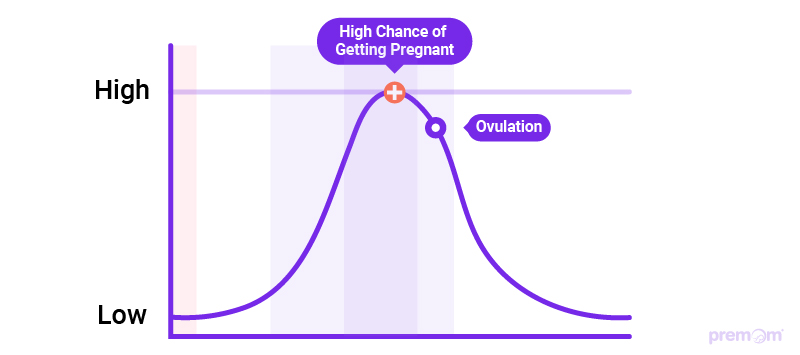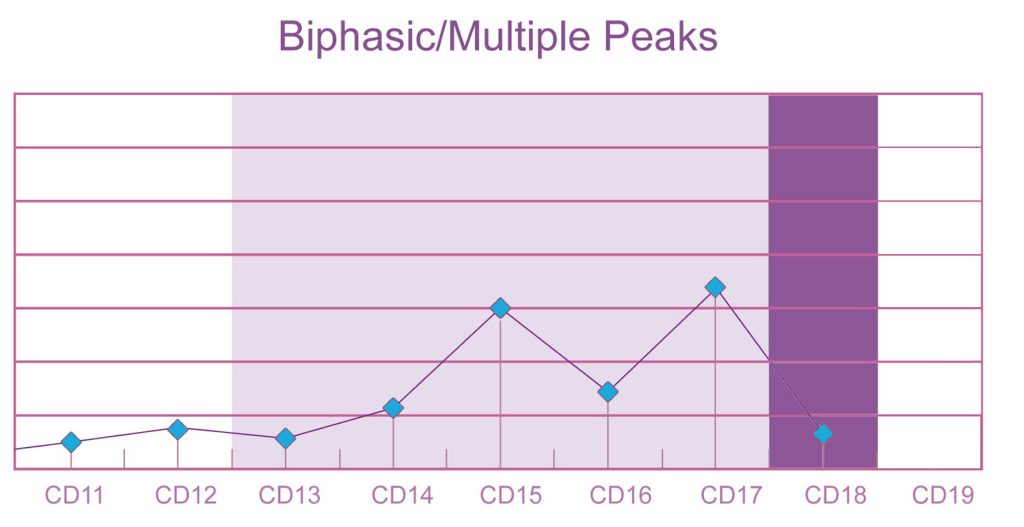An ovulation test and the ovulation test line progression are powerful tools for uncovering your menstrual cycle patterns and pinpointing your fertile window. Understanding events that occur during your cycle, including the differences between the LH surge vs LH peak, how ovulation tests work, and how to interpret your results can boost your confidence on your journey to get pregnant!
Luteinizing Hormone and Ovulation Day
Ovulation is the main event during a menstrual cycle when a mature egg is released from the ovary. Luteinizing hormone (LH) is the hormone solely responsible for triggering ovulation to occur each cycle. Once your body reaches a certain threshold of LH, also known as your LH peak, you can assume ovulation will occur in the next 24-36 hours. Once the egg is released, it only lives for 24 hours, whereas sperm can live up to 5 days in the female body.
The timing of ovulation varies from woman to woman. Most women believe they ovulate on cycle day 14 or CD 14, but in fact, “In only about 30% of women is the fertile window entirely within the days of the menstrual cycle identified by clinical guidelines-that is, between days 10 and 17,” according to a study published in The BMJ. This often leads to incorrectly timed intercourse while trying to get pregnant. Using ovulation predictor kits (OPKs) can help you understand your unique hormone patterns in order to pinpoint ovulation so you can get pregnant faster.
Low, High, and LH Peaks: What Do They Really Mean?
Your LH level readings (low, high, and peak) based on your urinary ovulation test results are key to understanding how to time conception efforts.

Low Fertility:
For most healthy women, LH starts at a low level at the beginning of your cycle, right after your period ends. This is the time your body is preparing for ovulation. Your ovulation tests may show no or very faint test lines. At this stage in your menstrual cycle, your chance of conception is low and you are not yet in your fertile window.
High Fertility:
As you approach ovulation, your LH levels will start to rise and continue to increase until you reach the LH peak, which occurs just before ovulation. During this phase, your ovulation test lines will become progressively darker, eventually reaching a point where the test line is as dark or darker than the control line indicating you have likely entered your fertile window. Conception chances at this point are good because sperm can survive up to 5 days within the fallopian tubes. Begin having intercourse every other day to maximize your chances of conception.
LH Peak (Peak Fertility):
The “LH peak” is when your luteinizing hormone reaches its highest concentration in the menstrual cycle. Your LH levels will continue to rise until your most recent test shows the darkest test line, darker than the control line, marking your LH peak day. This LH surge triggers the release of an egg, which typically occurs 24-36 hours later. The day before your LH peak, the peak day itself, and the day after (when ovulation occurs) are the three days with the highest chance of getting pregnant in your cycle.
At Premom, we have made everything automatic and straightforward with an automatic ovulation test digital reader! After taking an ovulation test, you only have to snap a picture of your ovulation test using the in-app camera. The app then automatically calculates your LH results. You can view your LH hormone progression using Premom’s ‘chart view’ to find your fertile window and peak fertility days easily!

High Fertility vs Peak Fertility: What’s the Difference?
High and peak fertility are both important for timing intercourse to increase your chances of pregnancy. When using ovulation tests, your results will continue to darken indicating that you are in your fertile window and your body is ramping up its preparation for ovulation. During this time, sperm can survive for several days and may still result in a pregnancy if you have sex.
On the other hand, peak fertility is a very specific period when you are at your most fertile. This occurs during the two days leading up to and including the day of ovulation. Peak fertility represents the optimal time for conception and is often accompanied by fertile cervical mucus that looks like egg whites.
In the simplest of terms, for LH surge vs LH peak, high fertility means your body is getting ready to ovulate soon, and peak fertility is your body’s way of saying, “Now’s the time!”
Can You Have More Than One Positive Ovulation Test Each Cycle?
It’s possible to experience multiple days of high LH levels, but it’s the last highest LH level that will successfully trigger ovulation and be considered your peak day.
Women who have multiple positive results have a gradual onset LH surge. With this type of surge, you may see multiple positive ovulation test results for more than one day before reaching your ultimate LH peak day, your last, highest level of LH.
Other women have what is called a rapid onset LH surge that peaks quickly within as little as a few hours. This means you may only see one positive ovulation test despite multiple days of testing. If you are new to testing or have been testing and have been unable to find your LH peak, you may benefit from testing twice daily as you could have a rapid onset surge and be missing your peak!
3 Common Types of LH Surge Patterns
TYPE 1: Single Peak
Some women have a steady rise and peak. In terms of ovulation tests, you will see the test line gradually getting darker, rising to your peak, and then getting lighter, descending back to baseline.
TYPE 2: Plateau
There is a second type of gradual onset, which is more of a “plateau.” In this case, you see consistently positive results with similar darkness before ovulation. Not one line seems to stand out more than other lines. In this case, we recommend you keep tracking until you see the test line begin to lighten again. That day is your most fertile day, and the last positive of that cycle is your peak day.
TYPE 3: Multiple Peaks

Still, other women experience some dips during their gradual rise — multiple peaks. In this case, they may see several ups and downs in the test line darkness over a period of a few days. This can be confusing!
Which one is the true peak ovulation test?
The last highest LH level is the true peak day that signals ovulation is about to occur. Multiple peaks happen in times of stress, illness, or hormonal change, but these are not necessarily the only times. When you think you have identified your LH peak, keep testing daily to ensure your levels return to baseline.
If you have ever received two peak readings or a second LH surge in one cycle just a couple of days apart, you may have experienced multiple follicular stimulation. What does that mean?
To achieve pregnancy, a follicle (casing and egg) is released from your ovary. The follicle must rupture to release the egg. In cases of multiple follicular stimulation, your body releases the follicle, but it doesn’t rupture. So, the egg is not released and you cannot get pregnant. Your body realizes this and releases a second follicle a few days later.
No matter what pattern you might have, remember that every woman is different. Even cycles can be different! The best way to get pregnant fast is to learn your patterns through education and smart tracking.
Premom’s automatic ovulation test reader makes reading your ovulation tests and identifying your unique patterns easy. Keep in mind that it can take a couple of cycles to get the hang of ovulation testing. Don’t feel discouraged if you’re not able to find your LH peak in your first cycle! If you have been tracking for a few cycles and are still having difficulty understanding your LH patterns or identifying your LH peak, schedule a virtual consultation with any of our fertility experts through your Premom app.
FAQs About LH Surge vs LH Peak
Is my LH peak day the same as ovulation day?
No, your LH peak day is when your ovulation test shows your last darkest test line. This indicates you will likely ovulate within the next 24 to 36 hours. You should see your levels on your ovulation tests begin to drop on your actual day of ovulation.
Can you ovulate before your LH peak?
Although unlikely, it is possible for ovulation to occur before the LH peak is detected on ovulation tests. If you experience a rapid LH surge, where the surge happens within hours, you might miss the peak if you’re not testing frequently enough. Additionally, ovulation could occur sooner than 24 hours after a peak reading, though this is rare.
What does “Peak” mean on my ovulation test?
Your ‘Peak’ ovulation test or ‘LH Peak’ means your highest, last darkest ovulation test result before your levels start to drop again. You can have multiple ‘High’ ovulation test results in one cycle, but you will only have one ‘Peak’ test result.
How long after LH peak is ovulation?
Ovulation typically occurs about 24 to 36 hours after your last darkest test line on an ovulation test known as your ‘LH Peak’. A day before your peak day, on your peak day and the day after are all good times to have intercourse to maximize your chances of conception.
References
https://pubmed.ncbi.nlm.nih.gov/17434509 – Characteristics of the urinary luteinizing hormone surge in young ovulatory women
Original publish date: September 20, 2022



